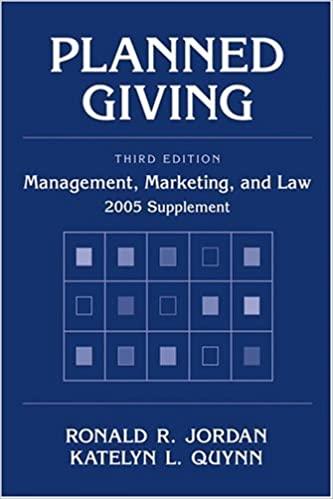Question
Question 1. A bookstore receives shipments of new books every day. The process of receiving and stocking new books includes three activities with the following
Question 1. A bookstore receives shipments of new books every day. The process of receiving and stocking new books includes three activities with the following sequence: 1- Unpacking and inspecting the books (done by worker W1), which takes 10 minutes per box. 2- Scanning the books into the bookstore system (done by worker W2), which takes 5 minutes per box. 3- Stocking the books on the shelves (done by worker W3), which takes 15 minutes per box. Assuming that the bookstore receives 24 boxes of new books every day and the workers work 8 hours per day, answer the following questions: (a) What is the input rate of boxes per hour? (b) What is the capacity rate of the process per hour? Show all your work and justify your answer, and do not forget the units. (c) What is the throughput rate of the process per hour? What does throughput rate mean in this context? Explain using the definition, context and the number you have obtained. (d) What is the utilization of each of the resources if the process runs for 8 hours a day and 24 boxes of books are received each day? Show details of your work, justify your answers, and include all the units.
2 Question 2. Baker's Delight offers a special promotion on Thursdays where customers can buy one loaf of bread and get another one for free. The bakery opens at 9am, but customers start lining up at 8:30am. Customers arrive at a rate of 30/hr until 10am and then at a rate of 20/hr until 12pm. The bakery can bake bread serve the customers at a rate of 25/hr, and the counter works till all customers served. (a) Draw the Inventory Build-Up diagram showing the number of customers waiting in line in 30-minute time slots. Start the graph at 8:30am and show the number of waiting customers until the line becomes empty. Use discrete time setting. (b) Using the inventory build-up diagram, calculate the average number of customers in line. (c) How long on average does a customer spend in line? (Hint: Littles Law. You need to compute average throughput rate first. Pay attention to units.)
Question 3. A t-shirt printing company produces 120 t-shirts per day. On average, there are 280 t-shirts in the work-in- process inventory at the facility. What is the average flow time of the process? Show your work, explain, and include all the units (this problem is made simple intentionally to practice Littles Law. There is nothing tricky here). You must use the notation (i.e., letters defined for each) taught in class, or a zero grade will be assigned to this question.
Question 4. A library has a single reference desk that provides research assistance to students. On average, 10 students arrive per hour at the desk. The reference librarian can help 12 students in an hour. Due to variability in the arrivals, the average number of students waiting in line is 1.8 students. You must use the notation (i.e., letters defined for each) taught in class, or a zero grade will be assigned to this question. Compute the following (Hint: Littles Law works for any system/sub-system: for the whole system including line and server combined, for the line only, and for the server only): (a) The utilization of the reference desk (b) The average number of students in the system (c) The average time a student spends waiting in line (d) The average time a student spends in the system
Step by Step Solution
There are 3 Steps involved in it
Step: 1

Get Instant Access to Expert-Tailored Solutions
See step-by-step solutions with expert insights and AI powered tools for academic success
Step: 2

Step: 3

Ace Your Homework with AI
Get the answers you need in no time with our AI-driven, step-by-step assistance
Get Started


